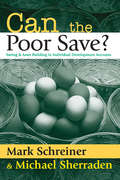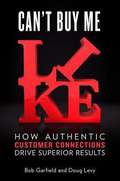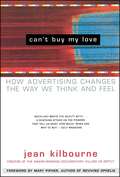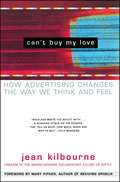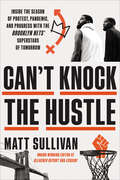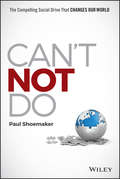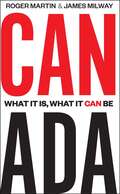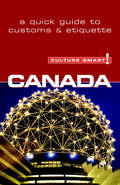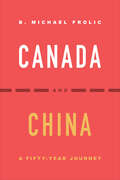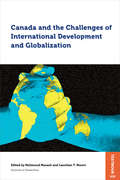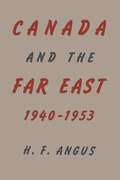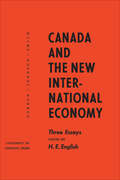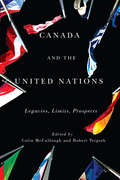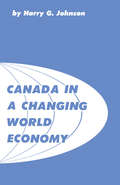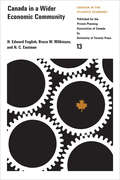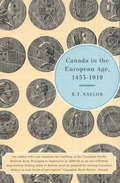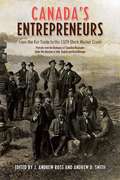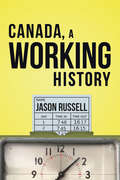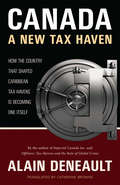- Table View
- List View
Can the Poor Save?: Saving and Asset Building in Individual Development Accounts
by Michael SherradenMany policymakers argue that the best poverty policy not only provides cash to the poor for subsistence but also incentives and structures that encourage long-term social and economic improvement. As part of this, they make the case for Individual Development Accounts (IDAs), a new policy proposal designed to help the poor save and to build assets. This book explores IDAs to determine their effectiveness. IDAs are matched savings accounts targeted on low-income, low-wealth individuals. Savings in IDAs are used for home ownership, post-secondary education, small business development, and other purposes. Do IDAs work? If they do, for whom? And does how an IDA is designed determine savings outcomes? This volume is the first analysis of matched savings by the poor to use data from monthly bank statements. It comes at a critical time, as debate rages over the merits of individual social security accounts. IDAs also respond to policy that is becoming more asset based and less inclusive of the poor. The authors argue for the efficacy of IDAs to counter this tendency. They find that while savings outcomes vary among participants, no characteristics (such as low income or public assistance) preclude saving. They examine effects of IDA design (the match rate, savings targets, and the use of automatic transfer) on savings results and analyze factors that influence varying rates of saving and spending over time. They conclude that financial education and other support services, though costly, improve savings performance. To address the issue of cost they suggest a two-tier system of IDA design, one with broad access and simple services and the other with targeted access and intensive services. Can the Poor Save? offers a wealth of lessons to those interested in saving and asset accumulation among the poor. It not only breaks new ground in the scientific study of savings behavior, but also offers concrete, evidence-based recommendations to improve policies designed to encourage the poor to save and how to make such policies more inclusive.
Can the World be Wrong?: Where Global Public Opinion Says We're Headed
by John Elkington Doug MillerWhen the global economy and world order become uncertain, where do we look for a sense of where things are heading? Can the World Be Wrong? lays out a compelling case for looking to long-term trends in global public opinion to help predict the future. Written by a pioneer of global polling, the book is provocatively illustrated by decade-long public opinion trends across 20 countries, on subjects ranging from geopolitics, globalization, the economy, the role of companies and the UN, to changing consumer trends and the future of democracy in the 21st century. Doug Miller, the founder and Chairman of the global research consultancy GlobeScan Inc., offers 30 never-before-released global opinion polls that inform this exposé of where the world may be headed. This essentially optimistic book delivers a fascinating briefing on below-the-radar trends that business leaders and policy-makers follow closely and thoughtful citizens need to understand. Miller brings his topics alive with behind-the-scenes looks at the World Economic Forum in Davos, the World Social Forum in Porto Alegre (Brazil), the International Business Leaders Forum in London, the United Nations Headquarters in New York, the White House, and boardrooms around the world. Can the World be Wrong? reveals what we really think of our leaders, businesses and policy-makers, and what this might all say about where we're headed in the 21st century. The book is essential reading for leaders, managers, policy-makers and researchers seeking to understand the power of global opinion and the implications it may have.
Can't Buy Me Like
by Bob GarfieldToday’s brands face an apparent choice between two evils: continue betting on their increasingly ineffective advertising or put blind faith in the supposedly mystical power of social media, where "likes” stand in for transactions and a mass audience is maddeningly elusive. There has to be a better way . . . As Lennon and McCartney wrote a half century ago, money can’t buy you love. But in today’s world, where people have become desensitized-even disillusioned-by ad campaigns and marketing slogans, that maxim needs an update: Money can’t even buy you like. That’s because we’ve entered the "Relationship Era,” where the only path for businesses seeking long-term success is to create authentic customer relationships. Not through hip social media promotions, viral videos or blizzards of micro-targeted online ads. Those tactics, which simply disguise old ways of thinking with new technology, just don’t work in the long run. So what does work in this bewildering new era? Where do "authentic customer relationships” come from? The answers will make some leaders sigh with relief while others rip their hair out: Honesty. Transparency. Shared values. A purpose beyond profit. Sure you still need a high-quality product or service to offer, but that’s not enough. Now that people can easily discover everything that’s ever been said about your brand, you can’t manipulate, seduce, persuade, flatter or entertain them into loyalty. You have to treat them like flesh-and-blood human beings, not abstract consumers or data points on a spreadsheet. It may sound like the woo-woo language of self-help books and inspirational wall posters. But as Garfield and Levy show in this book, it’s the deadly serious reality of business in the 2010s. It’s why General Motors abandoned its $10 million annual budget for Facebook ads, and why some brands have hurt themselves badly on social media by nagging, interrupting, abusing and generally ticking off their customers. The good news is that some companies have already embraced the Relationship Era and are enjoying consistent growth and profits while spending substantially less on marketing than their competitors. The authors show what we can learn from case studies such as . . . Patagonia, a clothing company with a passion for environmentalism, which solidified its customer relationships by urging people NOT to buy one of its jackets. Panera Bread, which doubled per-store sales by focusing on ways to create a welcoming environment while spending just 1 percent of sales on advertising. Secret, the women’s antiperspirant brand, which gained significant share by focusing on its commitment to strong women. Krispy Kreme, which has built a near cult of loyal Facebook and Twitter fans, all but obliterating the need for paid advertising. Blending powerful new research, fascinating examples and practical advice, Garfield and Levy show how any company can thrive in the Relationship Era. .
Can't Buy My Love: How Advertising Changes the Way We Think and Feel
by Jean KilbourneThis frightening expose reveals how advertisers use what they know about consumers' inner desires and dreams to make sure they develop an addictive relationship to their products.
Can't Buy My Love: How Advertising Changes the Way We Think and Feel
by Jean Kilbourne"When was the last time you felt this comfortable in a relationship?"-- An ad for sneakers"You can love it without getting your heart broken." -- An ad for a car "Until I find a real man, I'll settle for a real smoke." -- A woman in a cigarette adMany advertisements these days make us feel as if we have an intimate, even passionate relationship with a product. But as Jean Kilbourne points out in this fascinating and shocking exposé, the dreamlike promise of advertising always leaves us hungry for more. We can never be satisfied, because the products we love cannot love us back.Drawing upon her knowledge of psychology, media, and women's issues, Kilbourne offers nothing less than a new understanding of a ubiquitous phenomenon in our culture. The average American is exposed to over 3,000 advertisements a day and watches three years' worth of television ads over the course of a lifetime. Kilbourne paints a gripping portrait of how this barrage of advertising drastically affects young people, especially girls, by offering false promises of rebellion, connection, and control. She also offers a surprising analysis of the way advertising creates and then feeds an addictive mentality that often continues throughout adulthood.
Can't Knock the Hustle: Inside the Season of Protest, Pandemic, and Progress with the Brooklyn Nets' Superstars of Tomorrow
by Matt Sullivan“Brilliantly audacious…written with the profundity of a sage baller and the acuity of a seasoned journalist.”—Kiese Laymon, New York Times bestselling author of Heavy An award-winning journalist's behind-the-scenes account from the epicenter of sports, social justice, and coronavirus, Can't Knock the Hustle is a lasting chronicle of the historic 2019-2020 NBA season, by way of the notorious Brooklyn Nets and basketball's renaissance as a cultural force beyond the game.The Nets were already the most intriguing startup in the NBA: a team of influencers, entrepreneurs and activists, starring the controversial Kevin Durant and Kyrie Irving. But this dynasty-in-the-making got disrupted by the unforeseen. One tweet launched an international scandal, pitting the team's Chinese owner and the league's commissioner against its players and LeBron James. The sudden death of Kobe Bryant, after making his final public appearance in Brooklyn, sent shockwaves through a turbulent season.Then came the unimaginable. A global pandemic and a new civil-rights movement put basketball's trend-setting status to the ultimate test, as business and culture followed the lead of the NBA and its empowered stars. No team intersected with the extremes of 2020 quite like the Brooklyn Nets, and Matt Sullivan had a courtside view.Can't Knock the Hustle crosses from on the court, where underdogs confront A-listers like Jay-Z and James Harden, to off the court, as players march through the streets of Brooklyn, provoke Donald Trump at the White House, and boycott the NBA's bubble experiment in Disney World. Hundreds of interviews—with Hall-of-Famers, All-Stars, executives, coaches and power-brokers across the world—provide a backdrop of the NBA's impact on social media, race, politics, health, fashion, fame and fandom, for a portrait of a time when sports brought us back together again, like never before.
Can't Not Do
by Paul ShoemakerWith so many social challenges facing our world, trying to effect change feels daunting. The problems are complex, the politics murky, and the players innumerable. Yet, every day there are regular heroes making a significant impact on our most intractable social issues. "Can't Not Do" is a catchphrase for the urge that captures the heart of effective social change agents--explaining, in their own words, their passion and drive: "I can't not do this." "It's not that I can do this, it's that I can't not." "I could not imagine not doing something about this issue." The surprising truth from the trenches is: we already have numerous proven solutions for our many social challenges; what our world needs most, and what most changes our children's future, are more people prepared and committed to act on their social impulses for the long haul. Innovation helps. Money helps, too. But greater numbers of committed people help the most. If you feel an internal, persistent call to do more for the world, Can't Not Do will help you to bridge the gap between "wanting to do" and "doing"--to access the drive of an effective change agent, to break through self-imposed barriers, to learn key principles for success, and to start seeing yourself acting as a change agent. There is no "secret sauce" someone is born with and no special club needed to be successful at social change. Rather, successful change agents share some fundamental orientations to the world and to their committed cause and, over time, learn certain lessons that help them become more effective. These lessons are reflected in Can't Not Do in seven seemingly simple questions that provide guideposts and unlock the reader's potential to make a difference for a social cause they care about. This isn't a self-help book. It's an inspiring narrative intertwined with a "street-readiness" dialogue, between the author and you, between you and your inner aspirations. These are authentic success stories, vital questions, and unconventional answers that can guide and inspire you to realize your greatest potential.
Canada
by Roger Martin James MilwayCanadians have achieved an enviable balance of economic prosperity and civic harmony, but as emerging countries like China, India, and Brazil take their place alongside developed economies, we cannot be complacent. Our high paying jobs, world-class learning and research institutes, excellent health care, and social safety nets exist only to the extent that we are innovative and competitive globally.Canada: What It Is, What It Can Be provides an incisive examination of this country's increasing prosperity gap - the difference in value between what we do create and what we could create if we performed at our full potential. As Roger Martin and James Milway demonstrate, although we are proud of our trading prowess, we do not participate as aggressively in world markets with innovative products and services as we could. While we want to take risks to achieve success, our business strategies and economic policies need to set the bar higher to achieve the success we want for Canada.Written in an accessible style that helps general readers understand complex economic concepts, Canada: What It Is, What It Can Be exposes the myths currently guiding our public policy, and provides ground-breaking new approaches for realizing our full prosperity potential.
Canada - Culture Smart!: The Essential Guide to Customs & Culture
by Diane LemieuxCulture Smart! provides essential information on attitudes, beliefs and behavior in different countries, ensuring that you arrive at your destination aware of basic manners, common courtesies, and sensitive issues. These concise guides tell you what to expect, how to behave, and how to establish a rapport with your hosts. This inside knowledge will enable you to steer clear of embarrassing gaffes and mistakes, feel confident in unfamiliar situations, and develop trust, friendships, and successful business relationships. Culture Smart! offers illuminating insights into the culture and society of a particular country. It will help you to turn your visit-whether on business or for pleasure-into a memorable and enriching experience. Contents include: * customs, values, and traditions * historical, religious, and political background * life at home * leisure, social, and cultural life * eating and drinking * do's, don'ts, and taboos * business practices * communication, spoken and unspoken "Culture Smart has come to the rescue of hapless travellers." Sunday Times Travel "... the perfect introduction to the weird, wonderful and downright odd quirks and customs of various countries." Global Travel "...full of fascinating-as well as common-sense-tips to help you avoid embarrassing faux pas." Observer "...as useful as they are entertaining." Easyjet Magazine "...offer glimpses into the psyche of a faraway world." New York Times
Canada Mortgage and Housing Corporation in Motion
by Boris Groysberg Sarah L. AbbottEvan Siddall, newly appointed CEO of Canada Mortgage Housing Corporation, a governmental organization focused on the residential housing market, is charged with leading change at the organization. The case follows this process of change step by step and looks at the challenges Siddall faces. After two years of leading change Siddall questions: should he continue to push forward with a change agenda? Or should the organization pause and catch its breath?
Canada and China: A Fifty-Year Journey
by B. Michael FrolicPresenting a thorough record of Canada’s diplomatic ties with China, Canada and China recounts ten stories regarding China policy decisions made by the Canadian government. These decisions describe key bilateral moves, beginning with Pierre Trudeau’s recognition of China in 1970 and ending fifty years later with his son Justin’s attempt to reset a struggling relationship with China. Rooted in archival research, extensive interviews, and the author’s experience as a policy observer, the book contributes to our understanding of how the Canada-China relationship has developed over time and how best to position Canada in future relations with China. While present-day relations with China are complicated, the book deliberately seeks to provide a balanced perspective by showing both the positive and the more challenging aspects of relations with China. Ultimately, Canada and China recommends ways to manage future relations with China, while also honouring the ties it developed over fifty years.
Canada and the Challenges of International Development and Globalization (Studies in International Development and Globalization)
by Mahmoud Masaeli & Lauchlan T. MunroWhat are Canada’s various links with international development and globalization? They extend beyond foreign aid to diplomacy, trade, finance, aid, immigration, military intervention (both peacekeeping and combat roles), membership in a variety of international organizations, relations with indigenous peoples, and people-to-people links. This multi-disciplinary and multi-author textbook, designed for first- or second-year students, introduces the main concepts, theories, and perspectives that have shaped Canada’s interactions with developing countries in a globalizing world. It starts by considering Canada as a case study in international development and globalization. It examines Canada’s diplomatic, economic, military, social, immigration and aid policies, how they have changed over time and how they have interacted with each other and with Canada’s treatment of Indigenous peoples. The book presents economic, political, and cultural dimensions of the process of globalization and the ways they affect Canada; examines the public institutions, private sector and civil society organizations in Canada; and explores the moral imperatives behind Canadian international policy. Finally, it examines current issues, including Canada’s promotion of human rights, democracy, good governance, support to the private sector, and relations with fragile and conflict-affected states and the emerging economies. Finalist - PROSE Award, Textbook/Social Sciences January 2019 This book is published in English. - Comment se déploient les interventions du Canada en matière de développement international et de mondialisation ? Bien au-delà de l’aide à l’étranger, celles-ci touchent la diplomatie, le commerce, les finances, l’aide, l’immigration, les interventions militaires, l’adhésion à des organisations internationales et des liens entre personnes. Conçu pour les étudiants de première et de deuxième année du premier cycle, ce manuel multidisciplinaire est une initiation aux principaux concepts, idées, théories et approches qui forment le contexte historique et les fondations mêmes des interactions du Canada avec les pays en développement à l’ère de la mondialisation. Il aborde la question de la diplomatie canadienne et de son évolution, examine les politiques canadiennes en matière d’immigration, d’aide, de politique, d’économie, militaires et sociales. Il présente les dimensions économiques, politiques et culturelles du processus de mondialisation et les façons dont elles touchent le Canada, les institutions et politiques en lien avec le développement, les organismes du secteur privé et la société civile au Canada et les impératifs moraux qui sous-tendent la politique internationale canadienne. Enfin, il examine les droits humains, la démocratie, la bonne intendance, le soutien au secteur privé, les relations avec des états fragilisés et les liens avec les économies en émergence. Finaliste - PROSE Award, Textbook/Social Sciences Janvier 2019 Ce livre est publié en anglais.
Canada and the Far East: 1940-1953
by H. F. AngusThis book brings together and interprets the information relating to Canada's contacts with Asiatic countries since the beginning of the Second World War. Lucidly written and freshly presented, it will be of great interest to everyone concerned with international affairs. <P><P>As Canada's policies in the Far East and Southeast Asia are the result of Canadian policies in general, Dr. Angus discusses the general policies first and then their particular application. He deals with the nature of Canadian nationalism; the war years and post-war adjustment; Canadian Far Eastern policy and the United Nations; the peace settlement with Japan and security; trade policy and access to resources; economic assistance and the forms it takes; cultural intercourse, human rights, and immigration; and Canadian opinion about the Far East. <P>Dr. Angus' book is published by the University of Toronto Press for the Canadian Institute of International Affairs.
Canada and the New International Economy: Three Essays
by H. E. EnglishThe essays presented here arose from a strong feeling that it is very important at the present moment to stimulate thought in Canada on our position in the developing world economy. The authors have been concerned about the inward-looking emphasis in recent Canadian discussions of policy and are asking if a "status quo" approach to commerce is desirable or possible at a time when other nations are endeavouring to strengthen their economies by new adventures in liberal trade, especially in the form of regional trade groups. Peace, prosperity, and national identity are among our most cherished social objectives: how do and should they influence policy in the area of international trade?<P><P> With this shared background of interest the three authors examine trading of the past and the present. H. Scott Gordon (Carleton University) surveys the nineteenth century, Harry G. Johnson (University of Chicago) describes the emergence of regional free trade areas, and Arthur J.R.Smith (Canadian-American Committee) discusses Canada's policy problems in the rapidly changing trading world.<P> The essays were originally prepared as lectures in a highly successful series given at Carleton University earlier in 1961. H.E. English, editor of the collection, also contributes an introduction and a report of the discussion of the papers. He is Associate Professor of Economics, Carleton University.
Canada and the United Nations: Legacies, Limits, Prospects (Rethinking Canada in the World)
by Colin McCullough and Robert TeigrobA nation of peacekeepers or soldiers? Honest broker, loyal ally, or chore boy for empire? Attempts to define Canada’s past, present, and proper international role have often led to contradiction and incendiary debate. Canada and the United Nations seeks to move beyond simplistic characterizations by allowing evidence, rather than ideology, to drive the inquiry. The result is a pragmatic and forthright assessment of the best practices in Canada’s UN participation. Sparked by the Harper government’s realignment of Canadian internationalism, Canada and the United Nations reappraises the mythic and often self-congratulatory assumptions that there is a distinctively Canadian way of interacting with the world, and that this approach has profited both the nation and the globe. While politicians and diplomats are given their due, this collection goes beyond many traditional analyses by including the UN-related attitudes and activities of ordinary Canadians. Contributors find that while Canadians have exhibited a broad range of responses to the UN, fundamental beliefs about the nation’s relationship with the world are shared widely among citizens of various identities and eras. While Canadians may hold inflated views of their country’s international contributions, their notions of Canada’s appropriate role in global governance correlate strongly with what experts in the field consider the most productive approaches to the Canada-UN relationship. In an era when some of the globe’s most profound challenges – climate change, refugees, terrorism, economic uncertainty – are not constrained by borders, Canada and the United Nations provides a timely primer on Canada’s diplomatic strengths.
Canada in a Changing World Economy
by Harry JohnsonThe echoes of Laurier's remarks about Canada and the twentieth century are taking a long time to fade away. It is one of the purposes of Professor Johnson's Alan B. Plaunt Lectures (given at Carleton University in 1962) to silence them, for they can prove dangerous and misleading—like a siren song—in the formulation of Canadian economic policy at this time. The success of the Common Market, Britain's request for membership. President Kennedy's desire for tariff flexibility and reductions in the United States, and the recent stagnation in the North American economy (accentuated in Canada by an emphasis on monetary stability)—these are signs of change in the economic climate of the world. The requisite adaptations are the most important problem facing those who govern the economic life of this country, and they must be faced realistically to ensure Canada's continuing economic growth. Professor Johnson analyses his subject with his customary authoritative skill and lucidity. Written in non-technical language, this book presents an ideal summary of the contemporary economic world as it affects Canada.
Canada in a Wider Economic Community
by Bruce Wilkinson H. Edward English H. C. EastmanThe Private Planning Association of Canada initiated the Atlantic Economic Studies Program to study the implications for Canada of trade liberalization and closer economic integration among the nations bordering the North Atlantic. Over twenty studies by leading economists, which point out the significance of international trade for the structure and growth of the Canadian economy, have been published in a series of thirteen volumes. This is the last in the series, and it summarizes the conclusions expressed in the previous studies in chapters dealing with such topics as the growth of world markets and changing trade patterns, free trade alternatives for Canada, and the structure of the Canadian economy.
Canada in the European Age, 1453-1919
by R.T. NaylorAs Bruce Trigger explains in his preface, Canada in the European Age, 1453-1919 was the first history in which native peoples appeared as genuine actors in human dramas - mainly tragedies - instead of as part of the flora and fauna in the background. By stressing the interconnections between the grand events of the conquest and subjegation of the globe by European empire builders and the less dramatic events in Canada, Naylor's book led to a fundamental reinterpretation of Canadian social, economic, and political history.
Canada's Entrepreneurs
by Andrew Ross Andrew SmithMolson. Redpath. Desjardins. Labatt. Massey. Eaton. These names are as much a part of our national identity as our hockey teams and our literature, but few of us know much about the people behind them - the individuals who have energized this country's economic life for over four centuries, and whose entrepreneurialism has shaped the face of Canadian business as we know it.This captivating collection of biographies profiles Canada's most prominent and innovative business people from the early 1600s through the first quarter of the twentieth century. Beginning with an accessible overview of the rise of entrepreneurialism in Canada, it features portraits of 61 individuals organized thematically. Here, readers will meet a variety of seminal characters: the merchants of the first trading posts and the commercial empire of the St. Lawrence; the industrialists of the Maritimes, Central Canada, and the West; the railway builders and urban developers; and everyone in between.Bringing to the fore new Dictionary of Canadian Biography research on the rise of Canadian entrepreneurialism - one of the least explored yet most important themes in our history - this book showcases Canada's long-running tradition of business innovation and growth.
Canada, A Working History
by Jason RussellA deep exploration of the experience of work in CanadaCanada, A Working History describes the ways in which work has been performed in Canada from the pre-colonial period to the present day. Work is shaped by a wide array of influences, including gender, class, race, ethnicity, geography, economics, and politics. It can be paid or unpaid, meaningful or alienating, but it is always essential. The work experience led people to form unions, aspire to management roles, pursue education, form professional associations, and seek self-employment. Work is also often in our cultural consciousness: it is pondered in song, lamented in literature, celebrated in film, and preserved for posterity in other forms of art. It has been driven by technological change, governed by laws, and has been the cause of disputes and the means by which people earn a living in Canada’s capitalist economy. Ennobling, rewarding, exhausting, and sometimes frustrating, work has helped define who we are as Canadians.
Canada: A New Tax Haven
by Alain Deneault Catherine BrowneIn Canada: A New Tax Haven, Alain Deneault traces Canada's relationship with Commonwealth Caribbean nations back through the last half of the twentieth century, arguing that the involvement of Canadian financiers in establishing and maintaining Caribbean tax havens has predisposed Canada to become a tax haven itself - a metamorphosis well under way.Canada was linked to Caribbean nations long before they became tax havens. In the 1950s, an ex-governor of Canada's central bank attempted to establish a low taxation regime in Jamaica. In the 1960s, the transformation of the Bahamas into a tax haven characterized by impenetrable banking secrecy was shaped by a minister of finance who sat on the Royal Bank of Canada's board of directors. A Calgary lawyer and former Conservative Party heavyweight drew up the clauses that transformed the Cayman Islands into an opaque offshore jurisdiction. For years, Canadian politicians have debated annexing tax havens such as the Turks and Caicos Islands, making them part of Canadian territory. Canada has signed a free-trade agreement with Panama and is currently seeking a wider agreement with countries in CARICOM, the Caribbean economic community. And, notably, Canada currently shares its seat at the World Bank and the International Monetary Fund with a group of Caribbean tax havens.These exercises in fostering fiscal and banking leniency have predisposed Canada to become one of the most attractive tax havens to foreign interests. Not only does Canada offer one of the lowest corporate tax rates in the world, but a number of loopholes encourage companies to relocate to Canada as if it were Barbados or Bermuda.Canada: A New Tax Haven is an attempt to analyze the situation and address its implications for Canadians.
Canada: Financial Sector Assessment Program--Detailed Assessment of Observance of the CPSS/IOSCO Recommendations for Securities Settlement Systems
by International Monetary FundA report from the International Monetary Fund.
Canada: Financial Sector Assessment Program--Detailed Assessment of the Level of Implementation of the IOSCO Principles and Objectives of Securities Regulation
by International Monetary FundA report from the International Monetary Fund.
Canada: Report on the Observance of Standards and Codes--Data Module, Response by the Authorities, and Detailed Assessments Using Data Quality Assessment Framework
by International Monetary FundA report from the International Monetary Fund.
Canada: Selected Issues
by International Monetary FundA report from the International Monetary Fund.
